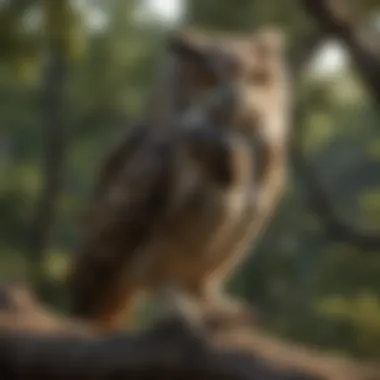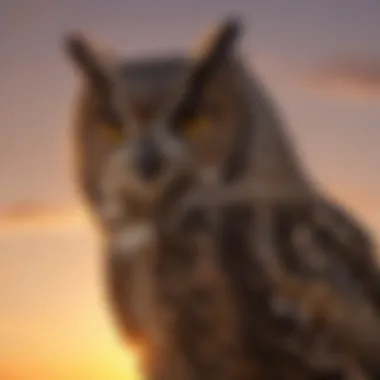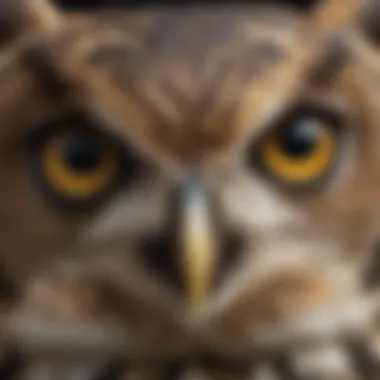Utilizing Owls as Natural Deterrents for Birds


Intro
In the constant struggle between various bird species and the environments they inhabit, owls emerge as a surprisingly effective solution. This article delves into the intriguing concept of harnessing the natural instincts of owls to deter unwelcome bird populations. As apex predators, owls possess unique behaviors and hunting strategies that empower them to manage the dynamics of local ecosystems. The following sections will provide an insightful exploration into the anatomy, habits, ecological roles, and practical considerations of utilizing owls as bird deterrents.
Animal Overview
Common Names
Owls are commonly recognized by several names, depending on the species. Popular types include the Great Horned Owl, Barn Owl, and Eastern Screech Owl. Each of these variations possesses distinctive traits that contribute to its effectiveness as a natural deterrent.
Scientific Classification
Owls belong to the order Strigiformes, which includes over 200 species categorized mainly into two families: Strigidae (true owls) and Tytonidae (barn owls). Understanding their classification aids in recognizing their unique attributes and roles in the ecosystem.
Geographic Range
Owls are found worldwide, with the exception of some isolated regions such as New Zealand and parts of the Arctic. Their adaptability to various habitats allows them to thrive in urban, rural, and wilderness settings. From North America to Africa and Asia, these raptors have established themselves in diverse environments.
Behavior and Social Structure
Social Behavior
Owls are predominantly solitary creatures. They prefer to hunt and reside alone, which aligns with their hunting strategies. Nevertheless, some species exhibit social tendencies during mating seasons or in regions with abundant food.
Communication
Communication amongst owls primarily occurs through vocalizations and body language. Their calls, ranging from hoots to screeches, serve as a means of establishing territory and attracting mates. These sounds can often be a deterrent in themselves, as they signal the presence of a predator.
Mating and Reproduction
Most owls are monogamous during the breeding season. The female typically lays one to five eggs, which both parents help to incubate. The young, known as owlets, remain dependent on their parents for an extended period before gaining independence.
Habitat and Ecosystem
Natural Habitat
Owls can adapt to various habitats, including forests, grasslands, and urban areas. Their choice of nesting sites often includes tree cavities, abandoned buildings, or cliff ledges, providing shelter and protection.
Food Sources and Diet
As carnivorous birds, owls primarily consume small mammals, birds, and sometimes insects. Their hunting techniques involve silent flight and acute hearing, allowing them to detect prey even in the cover of darkness. This predatory nature significantly impacts local bird populations, making them ideal for controlling pest species.
Role in Ecosystem
Owls play a crucial role in maintaining ecological balance. By preying on abundant bird populations, they help regulate species diversity and prevent overpopulation. This predator-prey relationship contributes to overall ecosystem health, illustrating the importance of owls in bird management strategies.


Utilizing owls as natural deterrents not only aids in bird control but also fosters a deeper understanding of the complex interactions within ecosystems.
Prelude to Owl Deterrence
Owls play a crucial role in the regulation of bird populations, especially those deemed unwanted. Their presence may not only deter these birds but also maintain balance within ecosystems. Understanding this concept is important as it provides an environmentally friendly alternative to other more invasive bird control methods. Incorporating owls as natural deterrents offers consistent long-term benefits for both agricultural settings and urban areas. This article aims to present a thorough exploration of the various aspects of utilizing owls for bird management.
Overview of the Problem of Unwanted Birds
Unwanted birds can pose multiple issues. These include crop damage, noise disturbances, and the transmittance of diseases. In agricultural contexts, flocks of birds can lead to substantial losses, both financially and in terms of crop viability. Urban areas often grapple with similar challenges, as certain bird species congregate in populated regions causing litter and potential health hazards. The need for effective bird control solutions grows as these problems escalate, emphasizing the importance of a comprehensive approach.
The Role of Owls in Ecosystems
Owls serve integral functions within their ecosystems. As predators, they help regulate populations of small mammals and various birds, establishing a form of natural balance. Unlike many birds of prey, owls tend to hunt at night, which allows them to take advantage of prey that may not be active during daylight hours. Their hunting techniques and nocturnal habits contribute to their effectiveness as deterrents for specific bird populations. Furthermore, the presence of owls can induce behavioral changes in unwanted birds, discouraging them from frequenting certain areas due to the perceived threat. This natural form of pest control thus promotes biodiversity, which is essential for ecosystem health.
Understanding Owl Behavior
Understanding the behavior of owls is crucial when considering their role as natural deterrents for unwanted bird populations. Their unique hunting skills, territorial tendencies, and activity patterns make them effective at controlling the presence of other birds. Knowing these aspects enables us to implement strategies that align with their natural instincts, thereby enhancing their efficacy in various environments. Understanding these elements is not only beneficial for researchers but also for anyone looking to utilize owls responsibly in their bird management efforts.
Hunting Techniques and Prey Preference
Owls exhibit distinct hunting techniques that contribute to their success as predators. They mainly rely on their acute senses of sight and hearing. Their large eyes allow for excellent night vision, enabling them to spot prey even in low light conditions. Additionally, owls can rotate their heads significantly, which helps in locating sounds in their vicinity, making them formidable hunters.
Owls typically prefer small mammals, insects, and occasionally birds as their primary prey. However, different species of owls may have varied dietary preferences. For instance, the Great Horned Owl often hunts larger birds, while the Barn Owl focuses on small rodents. Aquila ultrasonica
[1]: en.wikipedia.org/wiki/Owl#Diet. Owls may also exhibit specific hunting behaviors such as perching silently and swooping down on unsuspecting prey. This ability to adapt their hunting techniques to the type of prey they pursue is key to their survival and can be leveraged when trying to deter targeted bird species. Understanding these preferences helps to predict their impact on local bird populations effectively.
Territorial Characteristics
Territoriality is a noteworthy characteristic among owls, particularly during the breeding season. Most owl species establish and maintain territories which they defend vigorously. This trait is beneficial for controlling unwanted birds, as the presence of an owl can create a perception of danger, discouraging other birds from settling nearby. The size and quality of the territory often reflect the availability of food and nesting sites, which owls defend against intruders.
Key factors influencing territorial behavior include:
- Calling: Owls use vocalizations to assert dominance over their territory, warning others to stay away.
- Markers: Owls may utilize visual cues, such as droppings or feathers, to mark their territory.
- Physical Presence: The mere sight of an owl, especially in a restricted area, imparts a significant psychological effect on smaller birds, often deterring them from entering that space.
Nocturnal Activity Patterns
Owls are primarily nocturnal creatures, active during the night when they hunt for food. Their crepuscular behavior grants them a unique advantage, allowing them to hunt when many of their competitors are less active. Their nocturnal habits are matched with an acute sense of hearing and vision that is finely tuned for low-light conditions. This ability to thrive in the dark not only benefits their hunting strategies but also provides an alternative method for bird control when roosting birds are usually inactive, thus increasing the chances of a successful deterrent effect.
Consequently, these nocturnal patterns enable owls to elicit a natural response in birds, as many avian species tend to retreat during twilight hours. Understanding these patterns can greatly assist in timing placements of decoys or nest boxes to encourage owl habitation, making it more challenging for unwanted birds to persist in the same environment.
“The presence of an owl can act as a natural signal for other birds, self-regulating their populations.”
In summary, the essence of understanding owl behavior encompasses their hunting techniques, territoriality, and nocturnal activities. Each characteristic plays a crucial role in framing strategies to manage unwanted birds effectively. Proper knowledge of these elements not only informs decision-making but also establishes a more harmonious balance in ecosystems where both owls and birds coexist.
Methods for Implementing Owl Presence


The implementation of owls as natural deterrents is a strategic component in the approach to managing unwanted bird populations. Owls are remarkable predators and integrating them into various environments can yield effective results. Their presence can create a natural balance, reducing the reliance on chemical deterrents or other invasive measures. Understanding specific methods for implementing owls is essential for maximizing their effectiveness.
Artificial Owl Decoys
Artificial owl decoys offer a straightforward and accessible way to enhance owl presence in an area. These decoys are often designed to imitate real owls in appearance, size, and colors. Placing these decoys strategically can deter smaller birds effectively. Placement should consider the height and location, as these factors influence visibility and realism.
The benefits of using artificial decoys include:
- Cost-Effective: They are generally inexpensive compared to other deterrent mechanisms.
- Non-Invasive: They do not harm other wildlife or disrupt the existing ecosystem.
- Immediate Impact: They can provide quick results in deterring unwanted bird populations.
It’s important to move the decoys regularly. Stagnant decoys can lose their effectiveness over time as the target birds become accustomed to them. Rotating locations mimics the natural behavior of owls and increases the illusion of a real hunting presence.
Regular updates of the positioning and condition of the decoys are crucial to maintaining their effectiveness.
Nest Box Installation
Installing nest boxes specifically designed for owls can be an effective long-term strategy. This method involves creating a habitat that attracts owls to a particular area. Nest boxes should be constructed with sturdy materials and placed at appropriate heights. They need to be in locations that replicate natural nesting sites. This includes tall trees, open fields, or rural landscapes.
Nest boxes provide numerous advantages:
- Attraction of Natural Predators: They foster the presence of owls, thus providing a sustainable solution for bird management.
- Encouragement of Owl Breeding: Successful nesting can lead to a higher owl population, enhancing natural control.
- Community Engagement: Educating local communities about the benefits of nest boxes can foster interest in owl conservation.
Specific considerations for nest box installation involve:
- Site Selection: Choose locations with sufficient food supply and minimal disturbance.
- Maintenance: Regular cleaning and checking the condition of the boxes ensure longevity and usability for owls.
- Monitoring: Observation can help assess the effectiveness and make necessary adjustments.
In summary, the methods for implementing owl presence, including artificial decoys and nest box installations, play a vital role in leveraging these natural predators to control unwanted bird populations. Such strategies promote ecological balance while minimizing human intervention.
Efficacy of Using Owls
The efficacy of using owls as natural deterrents is a pivotal element in understanding how wildlife management can align with ecological principles. Owls possess unique hunting strategies and behaviors that allow them to naturally control bird populations. By harnessing the presence of these raptors, urban and rural settings can address the issue of unwanted birds effectively. This section discusses various case studies and the broader ecological impact of implementing owls as deterrents.
Case Studies in Urban Areas
Several urban environments have turned to owls as a less invasive method for managing bird populations. In cities where bird overpopulation leads to health risks and property damage, the introduction of owls has shown promising results. For example, in the heart of Chicago, property owners reported a significant decrease in pigeon infestations after implementing owl decoys in building rooftops and parks. These decoys, resembling native species such as the Great Horned Owl, provided a visual deterrent.
Another notable case occurred in San Francisco, where parks integrated nest boxes specially designed for Barn Owls. After a year of observation, the local bird population, especially starlings, noticeably declined. Not only did the presence of the owls curtail the unwanted species, but it also fostered a healthier ecosystem by allowing native birds shelter and resources to thrive.
These examples underscore the practical application of deploying owls as a remedy to urban avian problems.
Impact on Bird Populations
Utilizing owls as deterrents has significant implications for local bird populations. The control of invasive species by predatory owls contributes to the conservation of native birds. When owls are present, non-native species often retreat to areas less frequented by these birds of prey, leading to a more balanced ecosystem. This dynamic fosters better breeding conditions for native species, enhancing biodiversity.
Research indicates that in ecosystems where owls are actively present, the diversity of native bird populations tends to increase while the numbers of invasive species diminish.


However, considerations must be taken regarding non-target species. Introduction of owls could inadvertently affect smaller local birds, which may also be viewed as prey. It is crucial to study specific environments before implementing owl presence as a control method. Careful monitoring and assessment should be conducted to evaluate the long-term effects on all bird populations.
Ecological Considerations
The inclusion of owls as natural deterrents for unwanted birds raises numerous ecological considerations. It is vital to understand how such an approach can support or disrupt existing ecosystems, both in urban and rural contexts. This section delves into the importance of biodiversity, the balance within ecosystems, and potential impacts on non-target species.
Biodiversity and Balance in Ecosystems
Biodiversity is essential for the resilience and health of ecosystems. Using owls can promote a more balanced habitat by controlling populations of certain bird species that may otherwise proliferate uncontrollably. By reducing overpopulation of these birds, owls help maintain a natural equilibrium among various species. This natural form of pest control aligns with ecological practices that favor sustainability.
Owls serve as apex predators. Their presence signals to other wildlife that certain areas are governed by natural predation. As a result, smaller bird populations may become more regulated, fostering an environment where various species can thrive. This can enhance the ecological richness of a region, allowing for a diverse range of flora and fauna to coexist.
Ecological balance depends significantly on the interactions between different species. When higher bird populations lead to increased competition for resources, it can cause stress on local habitats. Introducing owls into this dynamic can mitigate such competition, allowing different species to share resources more effectively.
Potential Impact on Non-Target Species
While the focus on owls is beneficial, it is crucial to consider the potential impact on non-target species. The introduction of owls may inadvertently affect other birds and small mammals that are not the primary targets for control. For instance, smaller songbirds or other wildlife could become vulnerable due to the predatory nature of owls.
Furthermore, owls may also compete with other raptor species for food and nesting areas. This competition can lead to shifts in local populations, potentially endangering species that are already struggling to survive. It is essential to evaluate such dynamics before implementing owl-based deterrent measures.
To mitigate risks to non-target species, monitoring and research are necessary. Stakeholders should conduct studies to assess owls' influence on the broader ecosystem. By gathering data, it helps to understand the effects on various species and adjust strategies accordingly.
Practical Considerations for Implementation
Implementing owls as natural deterrents for unwanted birds requires careful thought. There are numerous factors to consider that can influence both the effectiveness and sustainability of this approach. Understanding practical considerations lays the groundwork for successful deployment and management of owls in various environments. This section examines cost-effectiveness, budgeting, and maintenance of owl-related deterrents.
Cost-Effectiveness and Budgeting
When considering the use of owls for controlling unwanted bird populations, cost-effectiveness emerges as a primary concern. Effective budgeting allows for proper allocation of resources, which impacts the overall success of the initiative.
- Initial Outlay: Investing in artificial owl decoys or nest boxes does require upfront costs. The prices vary based on quality and design. Using high-quality materials might involve higher initial spending but could lead to long-term savings by being more durable.
- Long-Term Benefits: Over time, the presence of owls can reduce the need for more aggressive bird control methods like chemical repellents or traps. This reduction not only saves on monetary costs but also minimizes potential ecological harm.
- Comparative Analysis: Evaluating the costs of owl utilization against traditional bird control methods can yield insights. For example, implementation costs of chemical deterrents may accumulate quickly, while once integrated, owls might naturally lower unwanted bird numbers over time.
- Financial Sustainability: Developing a budget that incorporates not only initial expenses but also ongoing costs will ensure a steady funding stream. Future allocation should consider maintenance and potential enhancements as new techniques and understanding of owl behavior develops.
In summary, a thorough financial plan significantly contributes to the successful implementation of using owls as deterrents.
Maintenance of Artificial Decoys
Artificial owls can be an effective short-term solution. However, regular maintenance is crucial for ensuring long-lasting efficacy. Inconsistent upkeep can lead to reduced effectiveness, making periodic checks necessary.
- Placement and Positioning: Regular inspections should be carried out to ensure that decoys are positioned correctly. When the decoys are in optimal locations, they are more convincing to other birds. Their effect diminishes if they become misaligned or if vegetation grows around them, obstructing visibility.
- Condition Monitoring: Weather exposure can degrade the physical integrity of decoys. Periodic assessment of the condition of each owl decoy will help identify any wear, tear, or fading that could make them less effective. Replacement may be necessary every few years depending on the climate conditions.
- Seasonal Adjustments: Bird behavior can change with the seasons. Adjustments in decoy positioning or adding new ones during peak migration periods may enhance effectiveness. This requires planning and monitoring throughout the year.
- Integration with Natural Species: Ensuring that the artificial decoys harmonize with the natural habitat will promote better results. Regularly observing actual owl behavior can inform the placement and style of decoys.
The End
The discussion of using owls as natural deterrents for unwanted bird populations holds significant importance within the context of ecological management and biodiversity preservation. Identifying methods that capitalize on the natural behaviors of owls not only serves to address the problem of excessive bird populations but also fosters a greater appreciation for these majestic creatures within their ecosystems. The key elements regarding the use of owls involve their effectiveness as predators, the minimal maintenance required for artificial deterrents, and the favorable ecological balance they promote, particularly in urban settings.
Summary of Findings
Through our exploration, we have established that owls possess inherent characteristics that make them suitable as a deterrent against certain bird species. Owls, as nocturnal predators, naturally instill fear in their potential prey. The installation of artificial owl decoys and nesting boxes has shown promise in attracting real owls, thus enhancing the deterrent effect. Studies demonstrate that areas where owls are present experience a measurable decline in unwanted bird populations, showcasing this strategy's effectiveness. Furthermore, the relatively low cost and ease of maintenance for artificial deterrents makes this approach accessible for various settings. Adoption of such methods contributes to a sustainable approach to bird management that aligns with ecological principles.
Future Research Directions
While current findings highlight impressive potential, the field stands to benefit from further research. Future studies could focus on the long-term effects of utilizing owls on bird populations across diverse environments. Specifically, research should investigate the interaction between owls and different bird species to understand better the nuances of their impact. Another area worthy of exploration is the technologies that can improve the effectiveness of artificial decoys, including sound or movement to mimic real owls more effectively. Additionally, understanding the behavioral ecology of various owl species can lead to tailored strategies for specific scenarios. By expanding our understanding of owls and their ecological roles, we can develop more effective, nature-based solutions for bird control.







